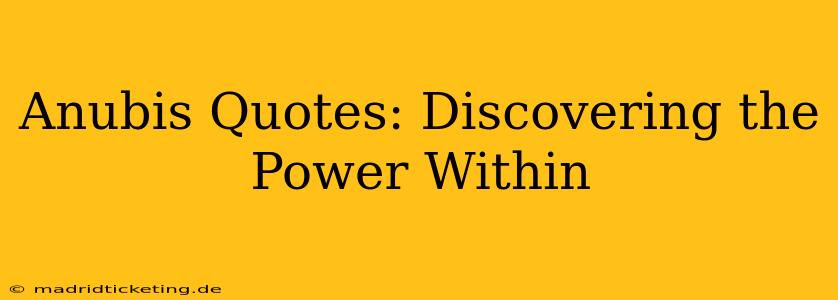Anubis, the jackal-headed god of the ancient Egyptian underworld, is far more than just a symbol of death. He represents transformation, judgment, and the powerful mysteries hidden within the cycle of life and rebirth. While direct quotes attributed to Anubis are scarce due to the nature of ancient mythology (much of our understanding comes from depictions and interpretations of his role), we can glean profound wisdom from his symbolic representation. This exploration delves into the powerful messages inherent in Anubis's imagery and the transformative power we can discover within ourselves, echoing the themes of his enigmatic presence.
What does Anubis represent?
Anubis is frequently depicted weighing hearts against the feather of Ma'at (truth and justice), symbolizing the judgment of souls in the afterlife. However, this portrayal only scratches the surface. He's also the protector of the dead, the guide through the underworld, and the embodiment of embalming—a process seen as crucial for successful transition to the afterlife. He represents not just death, but the necessary process of transformation and renewal that accompanies it. This makes Anubis a potent symbol of embracing change and confronting our own mortality to unlock inner strength.
What are some common misconceptions about Anubis?
A frequent misconception is that Anubis is solely a god of death and darkness. While associated with the underworld, he’s not a malevolent figure. He is a guide, a protector, and a facilitator of transition. He represents the necessary darkness that precedes rebirth and the wisdom gained through facing our fears and vulnerabilities. He doesn't inflict death; rather, he oversees the process and ensures a just transition.
What is the symbolism of Anubis's jackal head?
The jackal, a scavenger often seen near tombs, symbolizes Anubis's role as a guardian and protector of the deceased. Jackals are also associated with cunning, intelligence, and the ability to navigate complex situations—traits that reflect Anubis's role in guiding souls through the labyrinthine underworld. The jackal head thus embodies both the protective and guiding aspects of his divine nature.
How can I connect with Anubis's energy?
Connecting with Anubis's energy involves introspection and embracing transformative processes in your life. Reflect on areas where you feel stuck or resistant to change. Consider what aspects of yourself need to “die” to allow for growth and rebirth. Journaling, meditation, and mindful practices can facilitate this process. By confronting your fears and embracing the necessary darkness of personal transformation, you can tap into the powerful energy of renewal symbolized by Anubis.
What are some Anubis-inspired affirmations?
Inspired by Anubis's symbolism, we can create powerful affirmations for personal growth. Here are a few examples:
- "I embrace change and transformation with courage and grace."
- "I trust the process of death and rebirth, knowing it leads to renewal."
- "I honor my shadow self and integrate its wisdom into my being."
- "I am guided through challenges with clarity and strength."
Is Anubis a malevolent god?
No, Anubis is not typically depicted as malevolent. While associated with death and the underworld, his role is primarily that of a guide and protector. He oversees the transition of souls, ensuring a just judgment and a peaceful passage. The darkness he represents is not inherently evil, but rather the necessary aspect of life's cycle that precedes transformation and rebirth.
Conclusion: Embracing the Power of Transformation
Anubis offers a powerful message of acceptance and transformation. By understanding his symbolism and embracing the lessons inherent in his representation, we can access a profound source of inner strength. Facing our fears, acknowledging the inevitable cycle of life and death, and embracing change are crucial steps towards unlocking our own potential for growth and renewal – a journey echoing the transformative power symbolized by the enigmatic Anubis.

